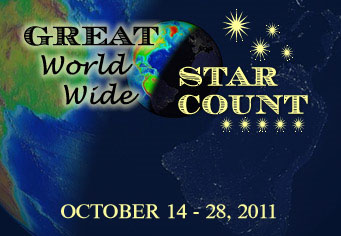This is the time of year when night falls reasonably early, the skies are haze free, outdoor temperatures are pleasant, and summer's bugs have gone away. All in all, it's a great stargazing season.
What would make it even more enjoyable for me, and likely for you too, is to somehow get rid of all the light pollution that pervades the modern nighttime sky. The ugly orangy pall of thousands of streelights and security lights has made the truly pristine night sky a rare sight.
(Just last week, the International Dark-Sky Association announced that Exmoor National Park in southwest England has been designated an International Dark-Sky Preserve — one of very few to earn that honor to date.)

Windows to the Universe / UCAR
So how starry is your starry night sky? You can find out easily, thanks to a sky-awareness campaign called Great World Wide Star Count. It'll take just 20 minutes or so, and you'll be joined by thousands of equally-curious skygazers around the globe. Do it on your own, with your family, or as part of a larger group.
All you'll need are a clear evening sky sometime between October 14th and 28th, your own two eyes, and a set of simple star charts. First, download the handy five-page activity guide (available in 15 languages!) and print the star charts. If you live in the Northern Hemisphere, you'll be looking high up for the constellation Cygnus, and its Northern Cross asterism. If you're south of the equator, the target area surrounds the Teapot in Sagittarius. Each of the seven maps shows stars down to a different magnitude limit, plus one for a cloudy sky.
Then, after stepping out under the early-evening sky and letting your eyes adjust to the darkness, match one of the charts to what you see overhead. Step back inside and report what you've found online. You're done!
Unlike many contests, you can enter this one more than once! You might be surprised by how much the sky's darkness can vary from night to night, or between locations only 1 or 2 miles apart.
Want to find out how quickly your eyes adapt to darkness? You can take a measurement as soon as you step outside, followed by another 15 or 30 minutes later.
GWWSC is a managed by UCAR's Windows to the Universe project. The first four years' efforts netted some 16,000 observations from scores of countries. This is a great example of "citizen science" that's helping to raise dark-sky awareness in every corner of the globe.
So, again I ask: How dark is your night sky? Join the Great World Wide Star Count and find out!
 0
0








Comments
You must be logged in to post a comment.